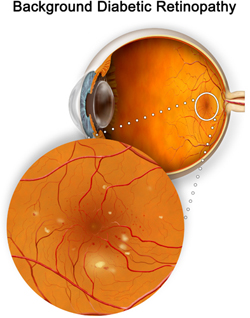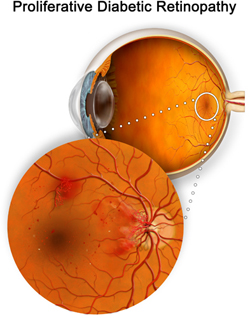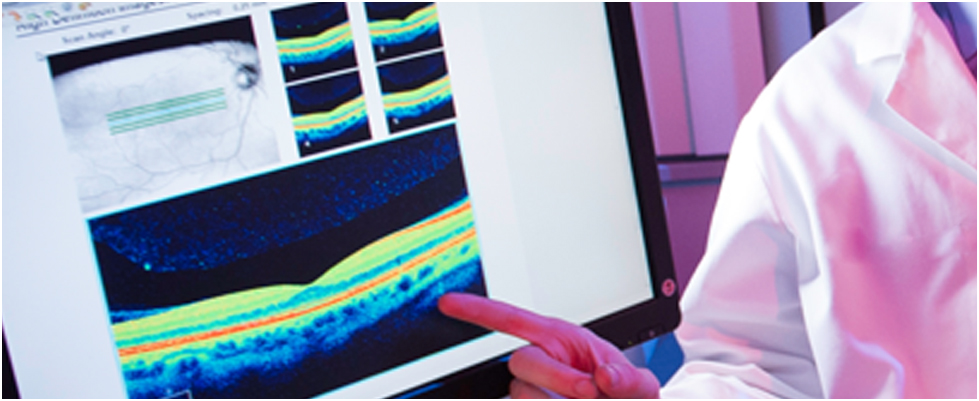About Eye Exams and Diabetic Retinopathy
By working together with patients and their primary care physicians, the eye doctors at Baltimore Washington Eye Center can help to slow or even prevent vision loss from diabetic eye problems and diabetic retinopathy. While there is no cure for diabetic retinopathy, annual dilated eye exams for patients with diabetes are essential for early detection, diagnosis and treatment of diabetic retinopathy. Recent data from the Centers for Disease Control shows that diabetes affects approximately 26 million people in the United States with almost 8 million people ages 40 and older suffering from diabetic retinopathy and that diabetes is now the leading cause of new blindness in adults 20-74 years of age.
Diabetic retinopathy is a complication of diabetes characterized by a weakening of blood vessels in the retina so that they leak, causing the retina to swell, bleed, and become deprived of oxygen and nutrients, ultimately leading to vision loss.
It is well documented that tight blood sugar control delays the onset and slows the progression of diabetic retinopathy. It is also important for patients with diabetes to help reduce their risk of developing diabetic eye disease by not smoking, lowering their cholesterol and lipid profile, and controlling blood pressure, as well as working to eat a heart-healthy diet rich in fish, fruit and green leafy vegetables, and exercising. With early diagnosis and treatment, progression of diabetic eye disease and its associated vision loss can at a minimum be slowed, and in many cases vision loss from diabetic retinopathy can be prevented.
About Diabetic Retinopathy
 Diabetic Retinopathy occurs and progresses in stages. The earliest stage of diabetic retinopathy is called Mild Nonproliferative Retinopathy and is characterized by the presence of “dot” and “blot” hemorrhages and “microaneurysms” in the retina. Microaneurysms are areas of balloon-like swelling of the tiny retinal blood caused by the weakening of their structure. Mild Nonproliferative Retinopathy can be present without any change in your vision and usually does not require treatment unless it progresses or is accompanied by Diabetic Macular Edema. If you have Mild Nonproliferative Retinopathy, your doctor will make specific recommendations about how often you will need to be examined and whether additional diagnostic testing such as retinal photographs, optical coherence tomography (OCT) or fluorescein angiography might be necessary.
Diabetic Retinopathy occurs and progresses in stages. The earliest stage of diabetic retinopathy is called Mild Nonproliferative Retinopathy and is characterized by the presence of “dot” and “blot” hemorrhages and “microaneurysms” in the retina. Microaneurysms are areas of balloon-like swelling of the tiny retinal blood caused by the weakening of their structure. Mild Nonproliferative Retinopathy can be present without any change in your vision and usually does not require treatment unless it progresses or is accompanied by Diabetic Macular Edema. If you have Mild Nonproliferative Retinopathy, your doctor will make specific recommendations about how often you will need to be examined and whether additional diagnostic testing such as retinal photographs, optical coherence tomography (OCT) or fluorescein angiography might be necessary.
Moderate Nonproliferative Retinopathy is the second and slightly more severe stage of diabetic retinopathy. During this stage, some of the small blood vessels in the retina may actually become blocked. The blockage of these tiny blood vessels causes a decrease in the supply of nutrients and oxygen to certain areas of the retina. The best way to diagnose blockage of the small blood vessels in the retina is by having a diagnostic test called an Intravenous Fluorescein Angiogram (IVF). The Intravenous Fluorescein Angiogram is performed right in our office. The IVF is performed by injecting a fluorescent dye into an arm vein and then, using a specialized camera, taking a series of photographs of the retina as the dye circulates throughout the retinal blood vessels. Using the IVF, it is possible to precisely and directly observe the circulation and the integrity of the blood vessels in the retina so that we can identify any blood vessels that may be blocked.
Severe Nonproliferative Retinopathy is the next progression of diabetic retinopathy. Severe Nonproliferative Retinopathy is characterized by a significant number of small blood vessels in the retina becoming blocked. As a greater number of blood vessels become blocked, it results in more areas of the retina being deprived of nourishment and oxygen. A lack of sufficient oxygen supply to the retina results in a condition called “Retinal Ischemia”. To attempt to compensate for “Retinal Ischemia”, these areas of the retina send chemical signals to the body to stimulate the growth of new blood vessels in order to try and reestablish the supply of oxygen.
 The next stage, Proliferative Retinopathy is a stage of diabetic retinopathy that carries a significant risk of vision loss. The retina responds to a lack of oxygen, or ischemia, by growing new, but abnormal blood vessels, a process called neovascularization. When retinal neovascularization is present, you have progressed into the Stage of Diabetic Retinopathy called Proliferative Retinopathy. At first, it might seem that new blood vessel growth, or neovascularization, is a desirable event as it will help the retina obtain greater blood flow and thus more oxygen and nutrients. Unfortunately, this is not the case. Retinal Neovascularization involves new blood vessels that are extremely fragile and tend to break easily and bleed into the Vitreous.
The next stage, Proliferative Retinopathy is a stage of diabetic retinopathy that carries a significant risk of vision loss. The retina responds to a lack of oxygen, or ischemia, by growing new, but abnormal blood vessels, a process called neovascularization. When retinal neovascularization is present, you have progressed into the Stage of Diabetic Retinopathy called Proliferative Retinopathy. At first, it might seem that new blood vessel growth, or neovascularization, is a desirable event as it will help the retina obtain greater blood flow and thus more oxygen and nutrients. Unfortunately, this is not the case. Retinal Neovascularization involves new blood vessels that are extremely fragile and tend to break easily and bleed into the Vitreous.
It may be possible for patients to have Proliferative Retinopathy and Retinal Neovascularization and yet still have good vision. Even if Proliferative Retinopathy and Retinal Neovascularization do not appear to be causing any vision loss, it is critical that you be treated as quickly as possible in order to stop the progression and preserve vision.
Vision loss from diabetic retinopathy can be slowed or avoided through regular eye exams. If you or someone you know has diabetes and would like to learn more about the stages of diabetic retinopathy or needs an appointment for a diabetic eye exam, please call Baltimore Washington Eye Center at 800-495-3937 to schedule an appointment.


